CHEVROLET CAMARO 1994 4.G Owners Manual
Manufacturer: CHEVROLET, Model Year: 1994, Model line: CAMARO, Model: CHEVROLET CAMARO 1994 4.GPages: 292, PDF Size: 15.35 MB
Page 161 of 292
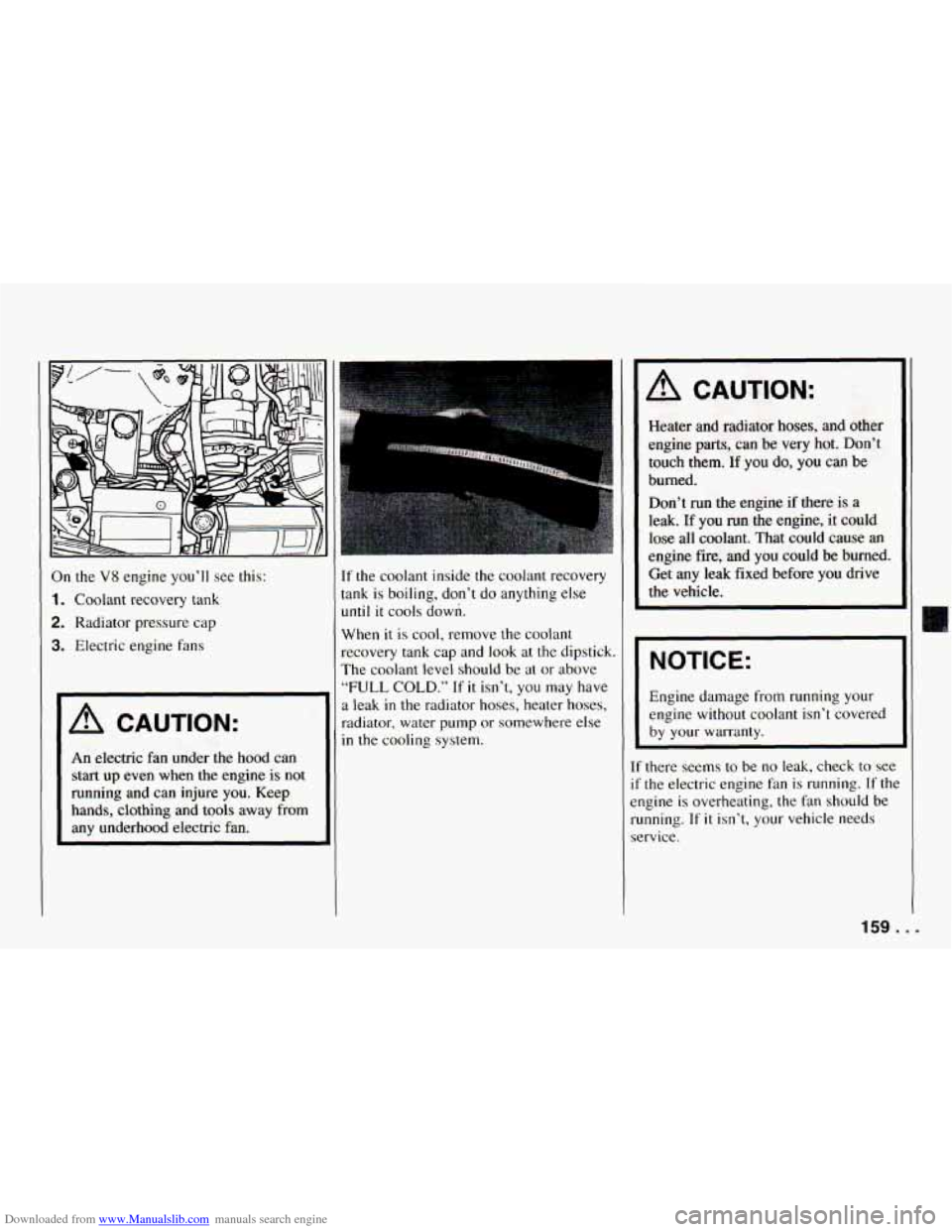
Downloaded from www.Manualslib.com manuals search engine On the V8 engine you’ll see this:
1. Coolant recovery tank
2. Radiator pressure cap
3. Electric engine fans
A CAUTION:
An electric fan under the hood can
start up even when the engine is not
running and can injure
you. Keep
hands, clothing and tools
away from
any underhood electric fan.
II
If the coolant inside the coolant recovery
tank is boiling, don’t do anything else
until it cools down.
When
it is cool, remove the coolant
recovery tank cap and look at
the dipstick.
The coolant level should be at or above
“FULL COLD.” If it isn’t, you may have
a leak
in the radiator hoses, heater hoses,
radiator,
water pump or somewhere else
in the cooling system.
A CAUTION:
Heater and radiator hoses, and other
engine parts, can be very hot. Don’t
touch them. If you do, you can be
burned.
Don’t
run the engine if there is a
leak. If you run the engine, it could
lose all coolant. That could
cause an
engine fire, and you could be burned.
Get any leak fixed before you drive
the vehicle.
NOTICE:
Engine damage from running your
engine without coolant isn’t covered
by your warranty. I
If there seems to be no leak, check to see
if the electric engine fan is running. If the
engine
is overheating, the fan should be
running.
If it isn’t, your vehicle needs
service.
159. I
Page 162 of 292
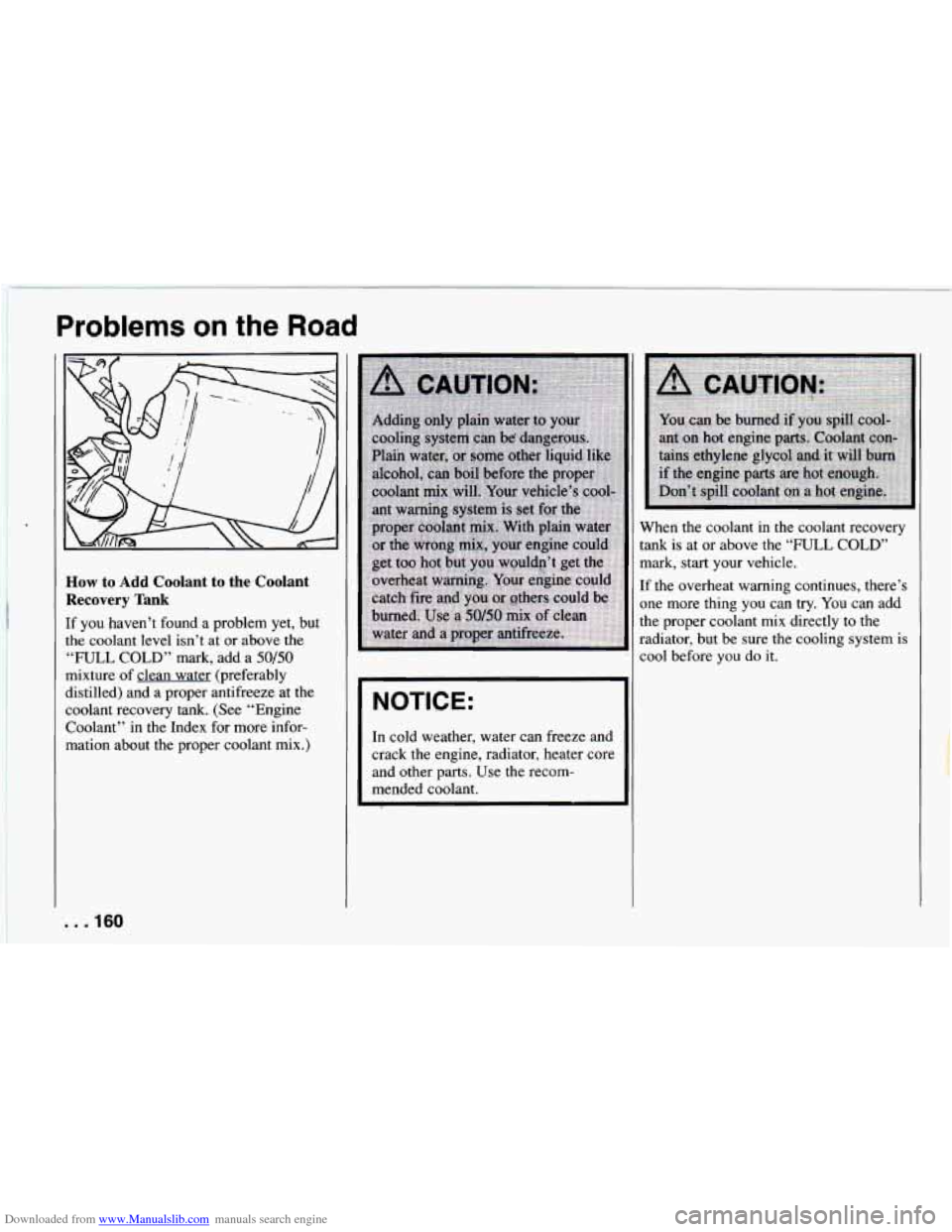
Downloaded from www.Manualslib.com manuals search engine Problems an the Road
How to Add Coolant to the Coolant
Recovery Bank
If yon .haven’t found a problem yet, but
the COOhint level isn’t at ur above the
“FULL COLD” mark, add a 50/50
mixture of clew wata (preferably
distilled) and a proper antifreeze at the
coolant‘rtyxwery ta&. (see “~nginef
Coolant” in the Index for more infor-
mation about the prop coolaat mix.)
c
I
NOTICE:
I
In cold weather, water can freeze and
crack the engine, radiator, heater core
and other parts. Use the warn-
mended coolant.
When the coolant in the coalant recovery
tank is at or above the “FULL GOLD”
mark, .start your vehicle.
If the overheat warning continues, there’s
one more thing you can try. You can add
the proper coolant mix directly to the
radiator, but be sure the cooling system is
cool before you do it.
. . .I60
Page 163 of 292
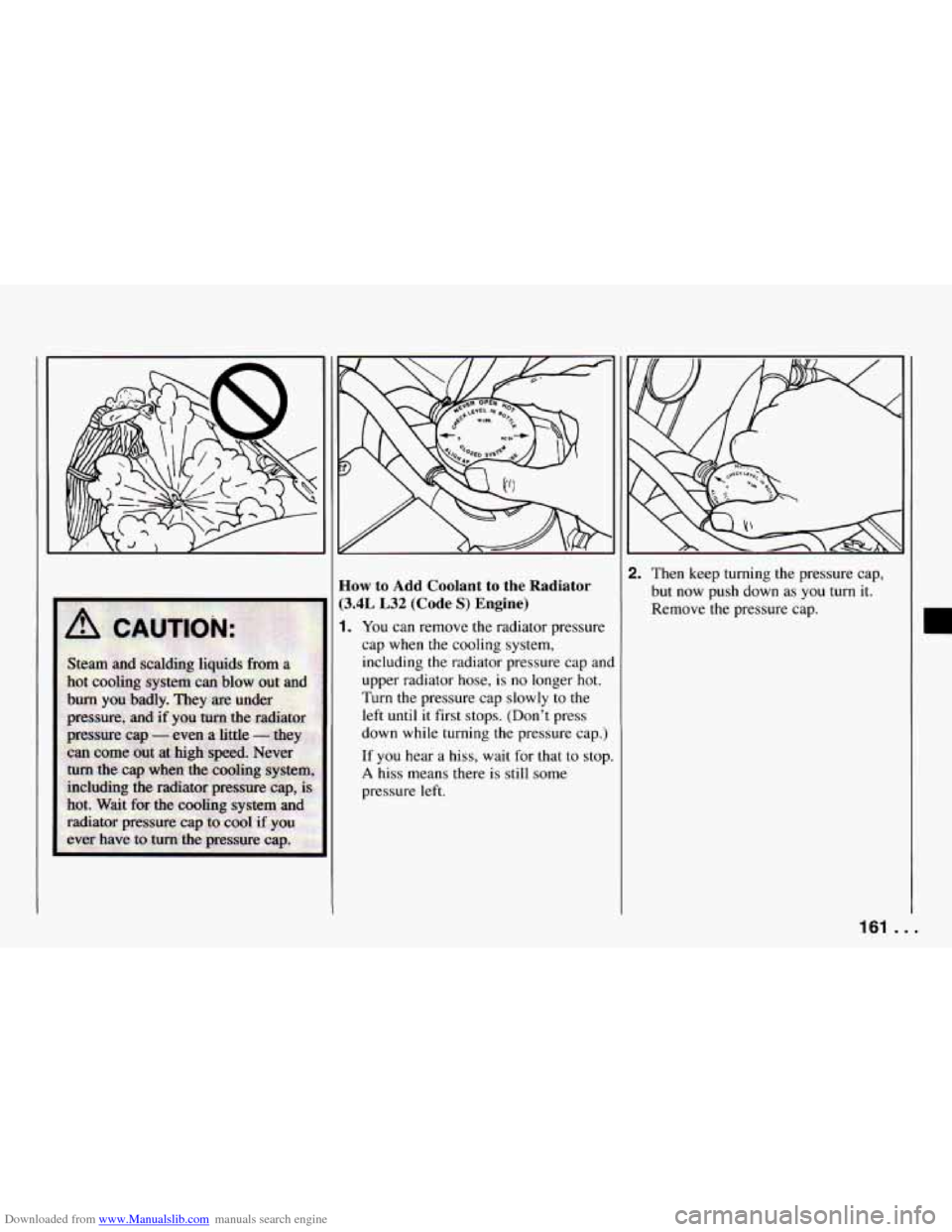
Downloaded from www.Manualslib.com manuals search engine How to Add Coolant to the Radiator
(3.4L L32 (Code S) Engine)
1. You can remove the radiator pressure
cap when the cooling system,
including
the radiator pressure cap ant
upper radiator hose, is no longer hot.
Turn the pressure cap slowly to the
left until it first stops. (Don’t press
down while turning the pressure cap.)
If
you hear a hiss, wait for that to stop
A hiss means there is still some
pressure left.
2. Then keep turning the pressure cap,
but now push down as
you turn it.
Remove
the pressure cap.
161 ..
Page 164 of 292
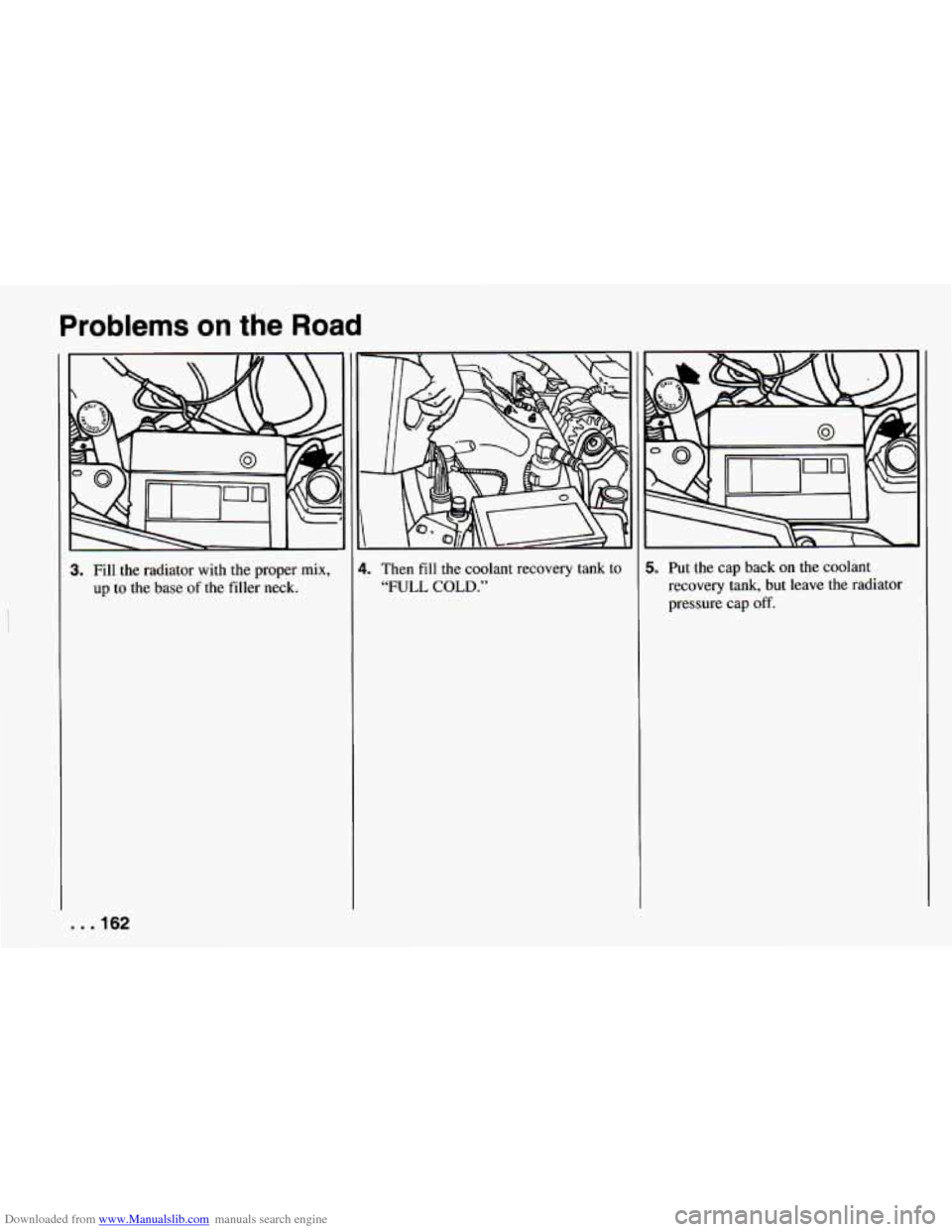
Downloaded from www.Manualslib.com manuals search engine Problems on the Road
3. Fill the radiator with the proper mix,
up
to the base of the filler neck.
4. Then fill the coolant recovery tank to
“FULL COLD.”
5. Put the cap back on the coolant
recovery tank, but leave the radiator
pressure cap
off.
. . .I62
Page 165 of 292
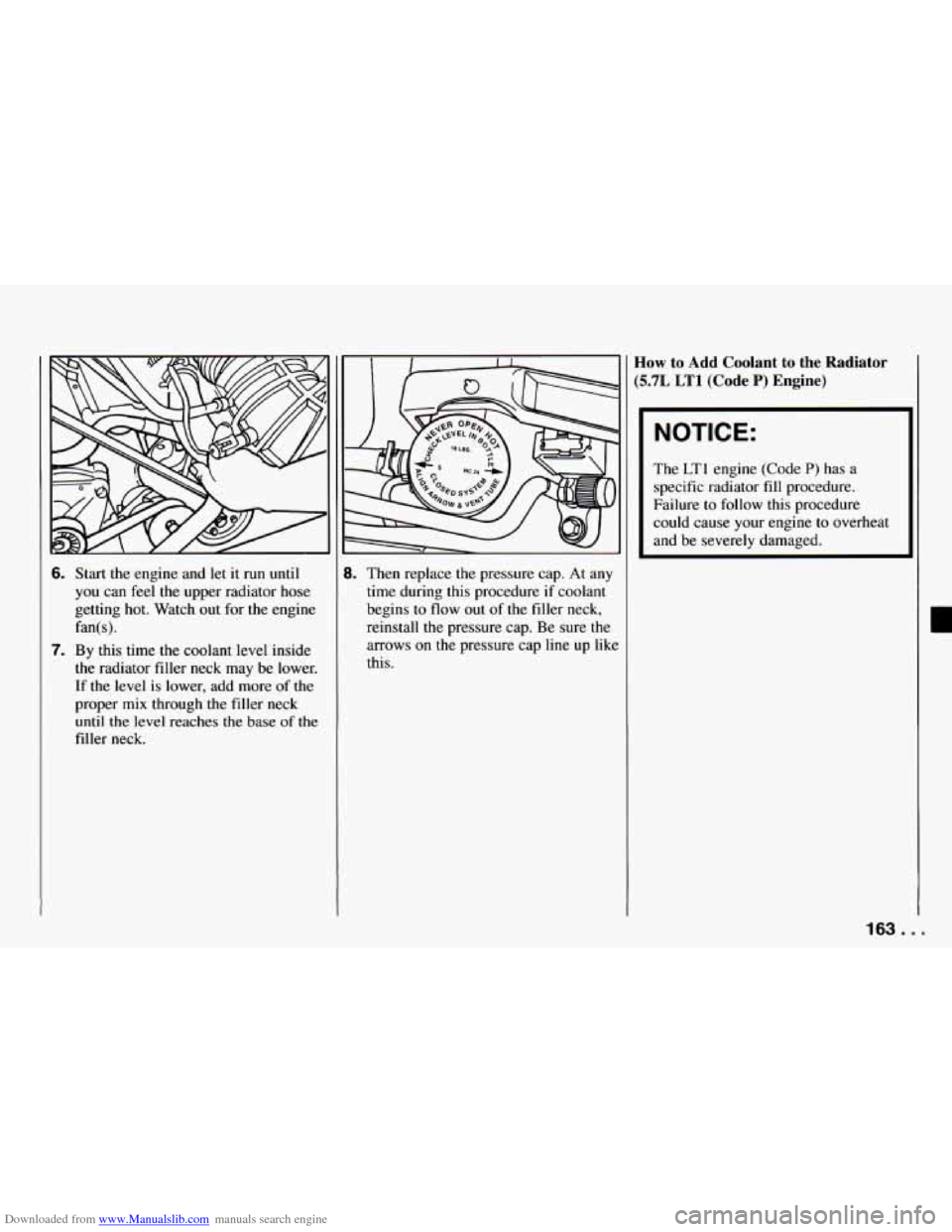
Downloaded from www.Manualslib.com manuals search engine 6. Start the engine and let it run until
you can feel the upper radiator hose
getting hot. Watch out for the engine
fan(s).
7. By this time the coolant level inside
the radiator filler neck may be lower.
If the level is lower, add more
of the
proper
mix through the filler neck
until the level reaches the base of the
filler neck.
8. Then replace the pressure cap. At any
time during this procedure if coolant
begins to
flow out of the filler neck,
reinstall the pressure cap. Be sure the
arrows on the pressure cap line up
like
this.
How to Add Coolant to the Radiator
(5.7L LTl (Code P) Engine)
~ NOTICE:
The LTl engine (Code P) has a
specific radiator fill procedure.
Failure to follow this procedure
could cause your engine to overheat
and be severely damaged.
163 ...
Page 166 of 292
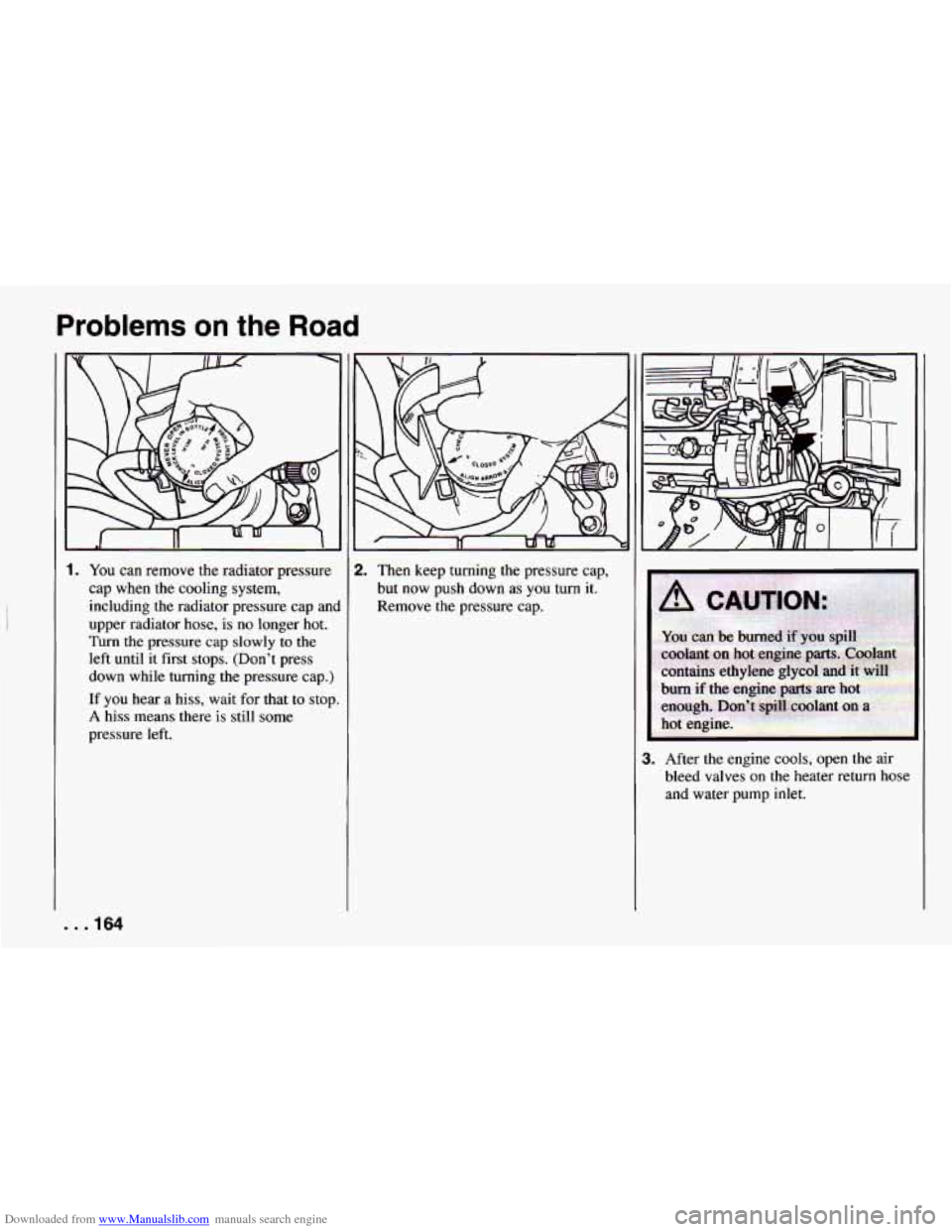
Downloaded from www.Manualslib.com manuals search engine Problems on the Road
1. You can remove the radiator pressure
cap when
the cooling system,
including the radiator pressure cap anc
upper radiator hose, is no longer hot.
Turn the pressure cap
slowly to the
left until it first stops. (Don’t press
down while turning the pressure cap.)
If you hear a hiss, wait for that to stop
A hiss means there is still some
pressure left.
~. Then keep turning the pressure cap,
but
now push down as you turn it.
Remove the pressure cap.
3. After the engine cools, open the air
bleed valves on the heater return hose
and water pump inlet.
. . .164
Page 167 of 292
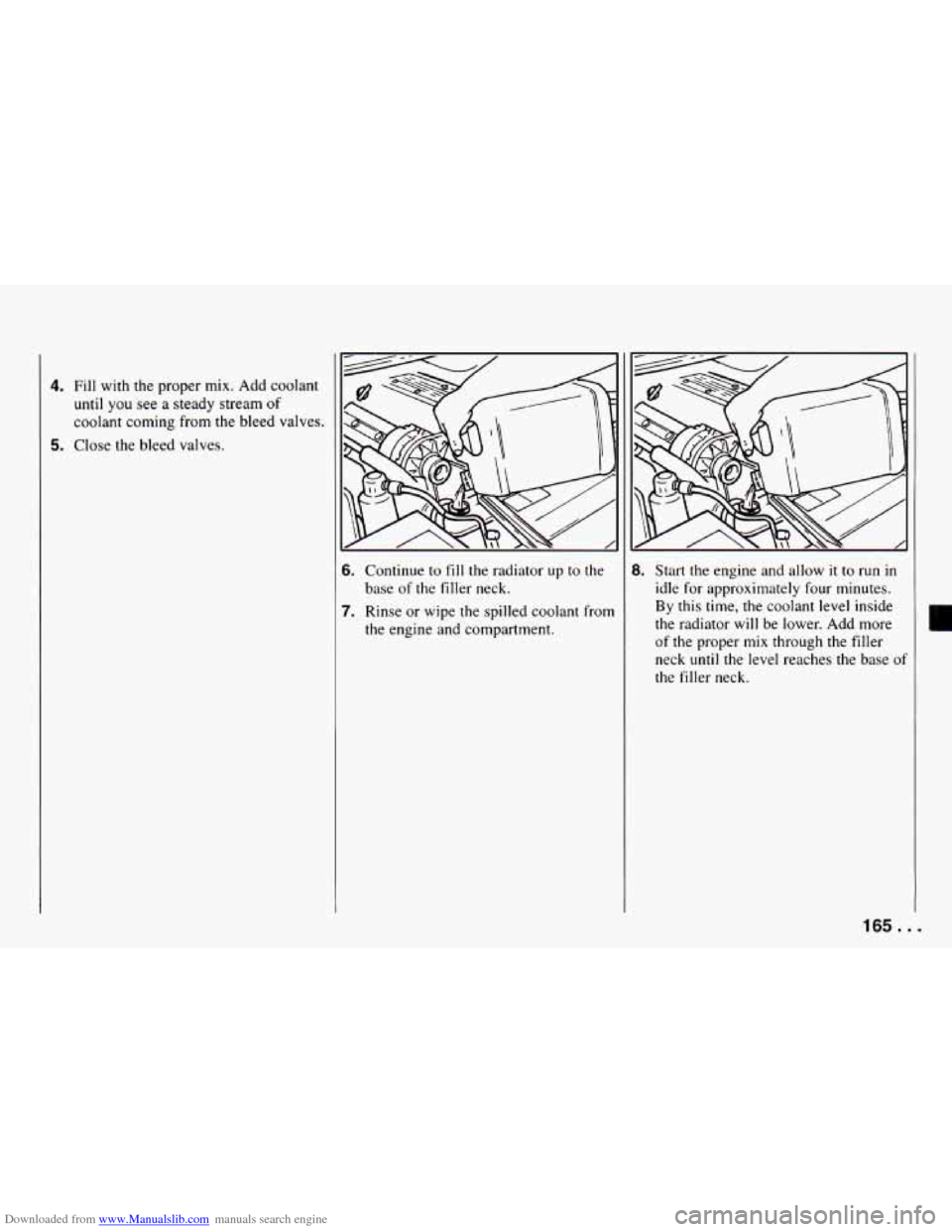
Downloaded from www.Manualslib.com manuals search engine 4. Fill with the proper mix. Add coolant
until you see a steady stream of
coolant coming from the bleed valves.
5. Close the bleed valves.
6. Continue to fill the radiator up to the
7. Rinse or wipe the spilled coolant from
base
of the filler neck.
the engine and compartment.
3. Start the engine and allow it to run in
idle for approximately four minutes.
By this time, the coolant level inside
the radiator
will be lower. Add more
of the proper
mix through the filler
neck
until the level reaches the base of
the filler neck.
165 ...
Page 168 of 292
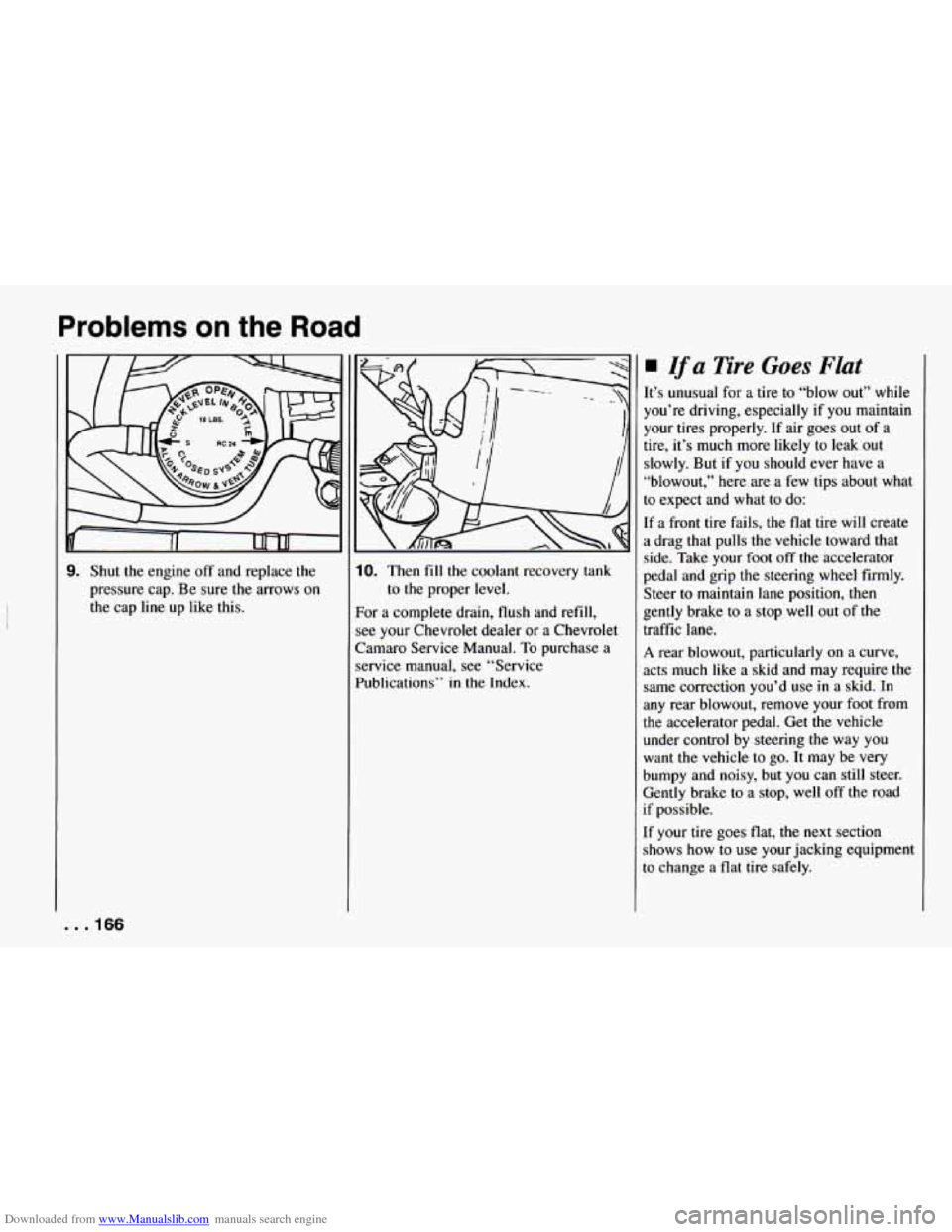
Downloaded from www.Manualslib.com manuals search engine Problems on the Road
3. Shut the engine off and replace the
pressure cap. Be sure the arrows on
the cap line up like this. 10. Then fill the coolant recovery tank
For
a complete drain, flush and refill,
see your Chevrolet dealer or a Chevrolet
Camaro Service Manual.
To purchase a
service manual, see “Service
Publications’’ in the Index.
to
the proper level.
If Q Tire Goes Flat
It’s unusual for a tire to “blow out” while
you’re driving, especially if you maintain
your tires properly. If air goes out of a
tire, it’s much more likely to leak out
slowly. But if
you should ever have a
“blowout,’’ here are a few tips about what
to expect and what to do:
If a front tire fails, the flat tire will create
a drag that pulls the vehicle toward that
side. Take your foot off the accelerator
pedal and grip the steering wheel firmly.
Steer to maintain lane position, then
gently brake to a stop well out of the
traffic lane.
A rear blowout, particularly on a curve,
acts much like
a skid and may require the
same correction you’d use in a skid. In
any rear blowout, remove your foot from
the accelerator pedal. Get the vehicle
under control by steering the way
you
want the vehicle to go. It may be very
bumpy and noisy, but you can still steer.
Gently brake to
a stop, well off the road
if possible.
If your tire goes flat,
the next section
shows how to use your jacking equipment
to change a flat tire safely.
. . ,166
Page 169 of 292
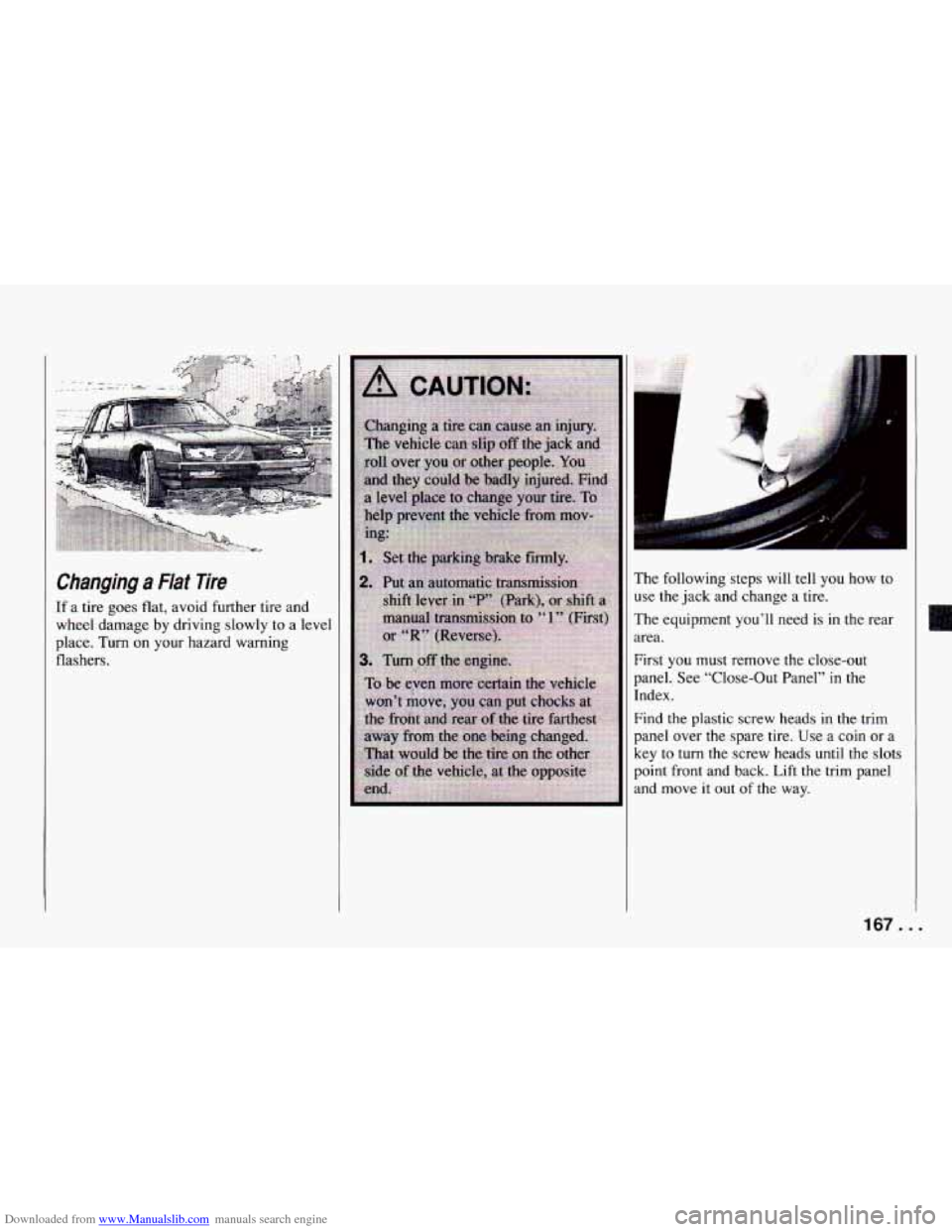
Downloaded from www.Manualslib.com manuals search engine Changing a Flat lire
If a tire goes flat, avoid further tire and
wheel damage by driving slowly to a level
place.
Turn on your hazard warning
flashers. The following
steps will tell you how to
use
the jack and change a tire.
The equipment you’ll need is in the rear
area.
First
you must remove the close-out
panel. See “Close-Out Panel” in the
Index.
Find the plastic screw heads in the trim
panel over
the spare tire. Use a coin or a
key to turn the screw heads until the slots
point front and back. Lift the trim panel
and move
it out of the way.
167..
Page 170 of 292
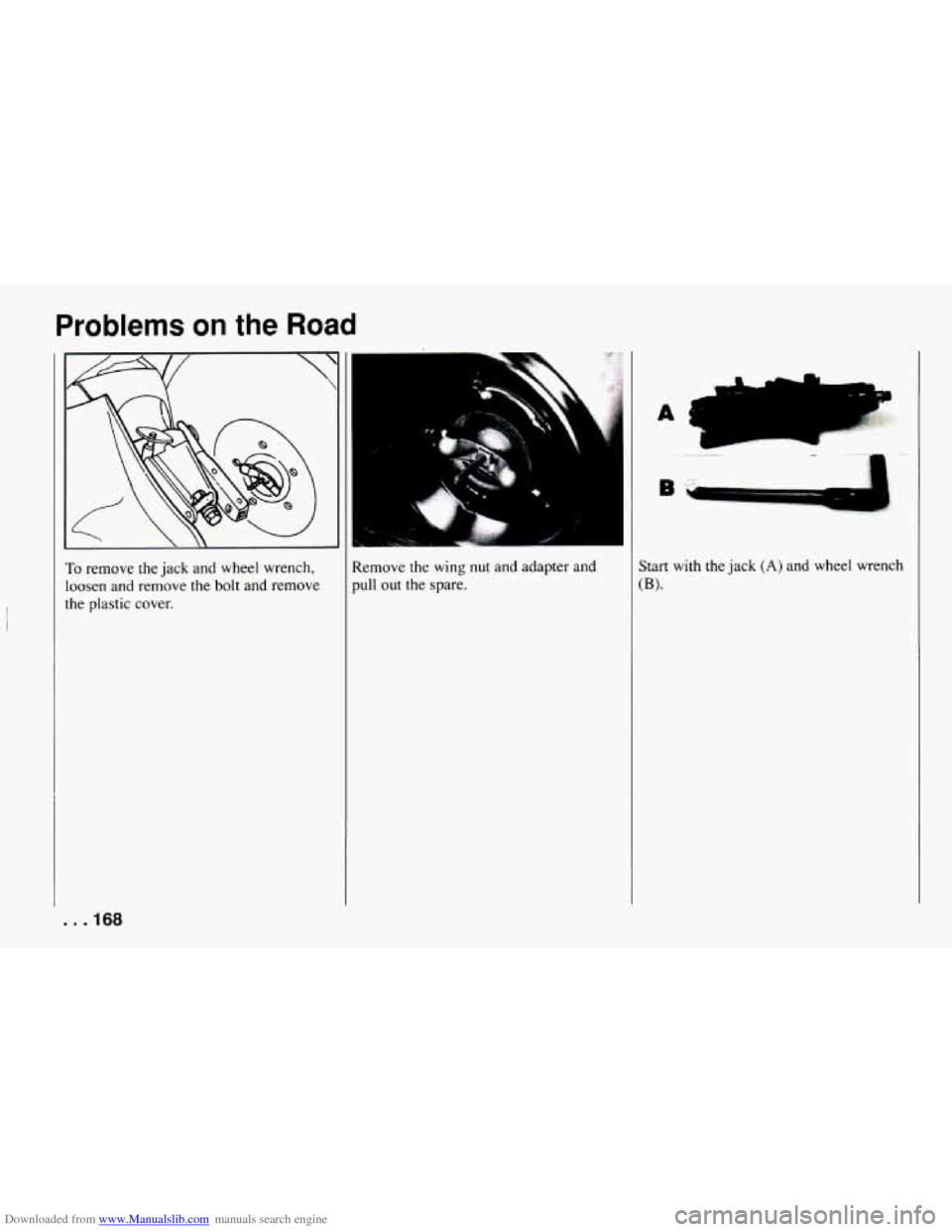
Downloaded from www.Manualslib.com manuals search engine Problems on the Road
To remove the jack and wheel wrench,
loosen and remove the bolt and remove
the plastic cover.
'.. .. . .
Remove the wing nut and adapter and
pull out the spare.
A
Start with the jack (A) and wheel wrench
(B).
. . .I68